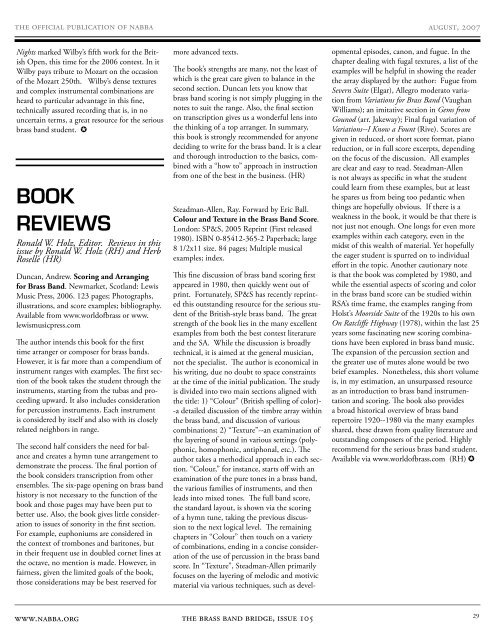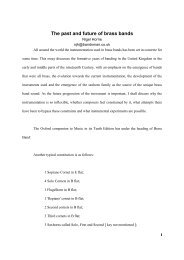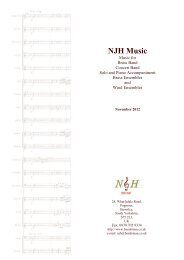Issue 105, August 1, 2007 - The Brass Band Portal
Issue 105, August 1, 2007 - The Brass Band Portal
Issue 105, August 1, 2007 - The Brass Band Portal
- No tags were found...
Create successful ePaper yourself
Turn your PDF publications into a flip-book with our unique Google optimized e-Paper software.
the official publication of nabba august, <strong>2007</strong>Nights marked Wilby’s fifth work for the BritishOpen, this time for the 2006 contest. In itWilby pays tribute to Mozart on the occasionof the Mozart 250th. Wilby’s dense texturesand complex instrumental combinations areheard to particular advantage in this fine,technically assured recording that is, in nouncertain terms, a great resource for the seriousbrass band student. JBOOKREVIEWSRonald W. Holz, Editor. Reviews in thisissue by Ronald W. Holz (RH) and HerbRoselle (HR)Duncan, Andrew. Scoring and Arrangingfor <strong>Brass</strong> <strong>Band</strong>. Newmarket, Scotland: LewisMusic Press, 2006. 123 pages; Photographs,illustrations, and score examples; bibliography.Available from www.worldofbrass or www.lewismusicpress.com<strong>The</strong> author intends this book for the firsttime arranger or composer for brass bands.However, it is far more than a compendium ofinstrument ranges with examples. <strong>The</strong> first sectionof the book takes the student through theinstruments, starting from the tubas and proceedingupward. It also includes considerationfor percussion instruments. Each instrumentis considered by itself and also with its closelyrelated neighbors in range.<strong>The</strong> second half considers the need for balanceand creates a hymn tune arrangement todemonstrate the process. <strong>The</strong> final portion ofthe book considers transcription from otherensembles. <strong>The</strong> six-page opening on brass bandhistory is not necessary to the function of thebook and those pages may have been put tobetter use. Also, the book gives little considerationto issues of sonority in the first section.For example, euphoniums are considered inthe context of trombones and baritones, butin their frequent use in doubled cornet lines atthe octave, no mention is made. However, infairness, given the limited goals of the book,those considerations may be best reserved formore advanced texts.<strong>The</strong> book’s strengths are many, not the least ofwhich is the great care given to balance in thesecond section. Duncan lets you know thatbrass band scoring is not simply plugging in thenotes to suit the range. Also, the final sectionon transcription gives us a wonderful lens intothe thinking of a top arranger. In summary,this book is strongly recommended for anyonedeciding to write for the brass band. It is a clearand thorough introduction to the basics, combinedwith a “how to” approach in instructionfrom one of the best in the business. (HR)Steadman-Allen, Ray. Forward by Eric Ball.Colour and Texture in the <strong>Brass</strong> <strong>Band</strong> Score.London: SP&S, 2005 Reprint (First released1980). ISBN 0-85412-365-2 Paperback; large8 1/2x11 size. 84 pages; Multiple musicalexamples; index.This fine discussion of brass band scoring firstappeared in 1980, then quickly went out ofprint. Fortunately, SP&S has recently reprintedthis outstanding resource for the serious studentof the British-style brass band. <strong>The</strong> greatstrength of the book lies in the many excellentexamples from both the best contest literatureand the SA. While the discussion is broadlytechnical, it is aimed at the general musician,not the specialist. <strong>The</strong> author is economical inhis writing, due no doubt to space constraintsat the time of the initial publication. <strong>The</strong> studyis divided into two main sections aligned withthe title: 1) “Colour” (British spelling of color)--a detailed discussion of the timbre array withinthe brass band, and discussion of variouscombinations; 2) “Texture”--an examination ofthe layering of sound in various settings (polyphonic,homophonic, antiphonal, etc.). <strong>The</strong>author takes a methodical approach in each section.“Colour,” for instance, starts off with anexamination of the pure tones in a brass band,the various families of instruments, and thenleads into mixed tones. <strong>The</strong> full band score,the standard layout, is shown via the scoringof a hymn tune, taking the previous discussionto the next logical level. <strong>The</strong> remainingchapters in “Colour” then touch on a varietyof combinations, ending in a concise considerationof the use of percussion in the brass bandscore. In “Texture”, Steadman-Allen primarilyfocuses on the layering of melodic and motivicmaterial via various techniques, such as developmentalepisodes, canon, and fugue. In thechapter dealing with fugal textures, a list of theexamples will be helpful in showing the readerthe array displayed by the author: Fugue fromSevern Suite (Elgar), Allegro moderato variationfrom Variations for <strong>Brass</strong> <strong>Band</strong> (VaughanWilliams); an imitative section in Gems fromGounod (arr. Jakeway); Final fugal variation ofVariations--I Know a Fount (Rive). Scores aregiven in reduced, or short score format, pianoreduction, or in full score excerpts, dependingon the focus of the discussion. All examplesare clear and easy to read. Steadman-Allenis not always as specific in what the studentcould learn from these examples, but at leasthe spares us from being too pedantic whenthings are hopefully obvious. If there is aweakness in the book, it would be that there isnot just not enough. One longs for even moreexamples within each category, even in themidst of this wealth of material. Yet hopefullythe eager student is spurred on to individualeffort in the topic. Another cautionary noteis that the book was completed by 1980, andwhile the essential aspects of scoring and colorin the brass band score can be studied withinRSA’s time frame, the examples ranging fromHolst’s Moorside Suite of the 1920s to his ownOn Ratcliffe Highway (1978), within the last 25years some fascinating new scoring combinationshave been explored in brass band music.<strong>The</strong> expansion of the percussion section andthe greater use of mutes alone would be twobrief examples. Nonetheless, this short volumeis, in my estimation, an unsurpassed resourceas an introduction to brass band instrumentationand scoring. <strong>The</strong> book also providesa broad historical overview of brass bandrepertoire 1920--1980 via the many examplesshared, these drawn from quality literature andoutstanding composers of the period. Highlyrecommend for the serious brass band student.Available via www.worldofbrass.com (RH) Jwww.nabba.orgthe brass band bridge, issue <strong>105</strong>29



![Finale 2002b - [SCORE.mus]](https://img.yumpu.com/43232372/1/184x260/finale-2002b-scoremus.jpg?quality=85)

